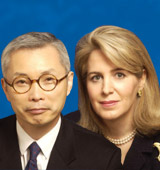(price minus cost)
by creating a leap in value for the
company itself by making a tidy
profit; and people proposition by
practicing fair process and
overcoming key organizational
hurdles. Allow me to give you an
example.Cirque du Soleil broke the
differentiation/low cost trade off to
grow from a rag-tag group of street
performers to a company pulling in
nearly $1 bn in revenues staging dozens of productions seen by over
40 million people in 90 cities around
the world. Instead of following the
conventional logic of outpacing the
competition by offering a better
solution to the given problem
creating a circuswith even greater fun
and thrills it redefined the problem.
Instead of trying to capture a larger
segment of the existing circus
customers (children and their
parents) Cirque looked to
noncustomers adults. And instead
of looking at competitors (other
circuses), it looked to alternatives
theater.
Cirque de Soleil dramatically raised
the utility customers received by
offering the fun and thrill of the circus
and the intellectual sophistication
and artistic richness of the theater.
Unlike traditional circuses featuring a
series of unrelated acts, each Cirque
production resembles a theater
performance in that it has a theme
and story line. As with Broadway
productions, too, each Cirque show
has an original musical score, which
drives the performance, lighting, and
timing of the acts. Next Cirque
focused on reducing its cost
structure. What they found was that
many of the elements considered
essential to the fun and thrill of the
circus were unnecessary and inmany
cases costly. For example, Cirque
eliminated animals, star performers,
three rings of continuous acts and
aisle concessions. Cirque found that
the lasting allure of the traditional
circus came down to just three
factors the clowns, the tent, and the
classic acrobatic acts. Therefore, these
elements of the traditional circuswere
maintained. All of the remaining
competitive elements were
eliminated.
Cirque offers the best of both circus
and theater. And by eliminatingmany
of the most expensive elements of the
circus, it has been able to dramatically
reduce its cost structure, achieving both differentiation and low cost. By
breaking the differentiation/low cost
trade-off, companies will create blue
oceans either by expanding the
existing markets or creating entirely
new ones.
Your findings are encouraging for
executives of large, established
corporations because they show that
large research and development
budgets are not crucial for creating
new market space. What about
executives of Small and Medium
scale Enterprises (SMEs), given
every country's focus is on SMEs.
Our findings should be encouraging
for managers of both SMEs and
established corporations since what
they reveal is that large R&D budgets
are not the key to creating newmarket
space. The key is making the right
strategic moves. Whats more,
companies that understand what
drives good strategic moves
startups or incumbents will be well
placed to create multiple blue oceans
over time, thereby continuing to
deliver high growth and profits over a
sustained period. The creation of
blue oceans, in other words, is a
product of strategy and managerial
action and not of the size or age of the
firm.
What do you suggest are the
prerequisites for embracing upon
creating a BOS in (a) a company
operating in a matured industry, (b)
a company operating in a growing
industry, and (c) a company
operating in a sunrise industry?
Please note our answer regarding our
contention that the strategic move
(the set of managerial actions and
decisions involved in making a major
market creating business offering) is
the correct unit of analysis for
explaining the creation of blue oceans
and the root of profitable growth.
